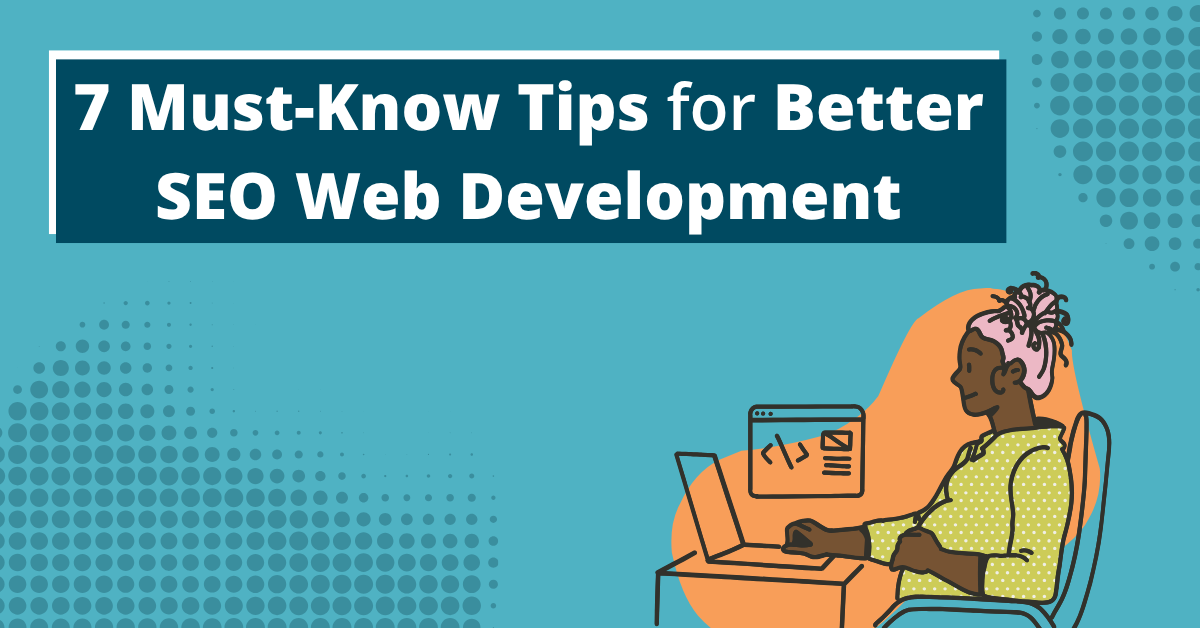7 Tips for SEO Web Developers
August 4th, 2025 by
Note:This post was updated by Shane Kretzmann on August 4, 2025 to reflect current best practices. It was originally published on August 13th, 2013.


Key Insights
- Web development and SEO are inseparable: A website’s technical architecture directly impacts its search visibility, from how search engines crawl content to how users experience load times and navigation.
- AI-powered search raises the stakes: Clean code, semantic structure, and SEO-friendly web design are now essential for staying competitive in Google Search results and AI-generated summaries.
- Core Web Vitals and mobile friendliness drive rankings: Prioritizing site speed, responsiveness, and accessibility (like screen reader compatibility) improves both user experience and SEO performance.
- Schema markup and structured content help Google understand your site: Implementing JSON-LD and organizing content hierarchies make it easier for search engines to surface your pages in relevant search queries.
- Collaboration between developers and SEO teams is critical: Embedding SEO best practices into the design process reduces last-minute launch issues and ensures important pages are optimized from day one.
SEO for web developers is critical to ensuring websites are both high-performing and search-friendly.
Web development has always been at the core of SEO success. But with AI-powered search engines rewriting how users discover content, developers are now more vital than ever to a site’s search visibility.
Every decision, from site structure to semantic markup, affects how a website performs in search engine results pages and whether it earns a spot in today’s AI-generated summaries.
Clean code? Essential.
Scalable architecture? Non-negotiable.
Fast-loading pages? A baseline for staying competitive.
Together, these elements define modern SEO web design. Developers who embrace this intersection of technical precision and search strategy create truly SEO-friendly websites.
In this blog, we’ll discuss seven actionable strategies for helping developers boost search visibility through smarter code, cleaner architecture, and AI-conscious design.

Optimize for Core Web Vitals from the ground up
Think of Core Web Vitals as your website’s fitness test for Google’s search algorithm.
Pass it, and you’re on the path to better search engine rankings and more traffic.
Fail, and even the best content won’t save you from sluggish performance.
Prioritize metrics like Largest Contentful Paint (LCP), First Input Delay (FID), and Cumulative Layout Shift (CLS). These aren’t just developer jargon; they’re signals directly impacting how search engines understand your site’s usability.
Use clean, efficient code. Lazy load images to reduce initial page weight. Compress media files, switch to modern formats like WebP, and preload key assets for critical rendering paths.
Here’s the kicker: AI-generated answers often deprioritize slow-loading sites altogether. If your web page lags, you’re invisible to users before the game even begins.
2. Build a semantic, crawlable site architecture
A tangled site structure is like sending search engines on a wild goose chase through Westeros — confusing, inefficient, and doomed to fail.
Instead, craft a logical hierarchy with clean, semantic HTML5 elements (header, nav, main, article, footer).
Leverage semantic heading structures (H1–H3) to guide bots and humans. Avoid burying critical content in JavaScript. Google’s search algorithm may never find it.
A structured DOM supports better passage-level indexing, allowing AI systems to retrieve precise answers from your site. This is a cornerstone of SEO for developers and a must for creating an SEO-friendly web design.
3. Use Schema markup for clarity and context
Search engines love clarity. Help them understand your site by implementing JSON-LD Schema for FAQs, breadcrumbs, organization, and product details.
Schema markup makes it easier for Google, Bing, and AI search engines to grasp your page’s purpose, increasing your chances of appearing in rich snippets and generative search snapshots.
For developers working on SEO website design, schema is no longer optional. It’s a baseline for visibility in voice assistants and AI-powered search queries.
4. Make every page AI search-ready
AI search doesn’t scan your whole blog post. It grabs self-contained chunks of content.
That means your job is to make each section stand on its own like a mini guide.
Use “chunking” strategies with clear H2s, keyword-rich summaries, and long-tail queries such as “What is SEO in web development?” or “How does web development impact SEO?”
An SEO-optimized page designed this way is more likely to surface in passage indexing and AI retrieval, driving more traffic to your site.
5. Reduce render-blocking elements & improve indexing signals
Every second counts. Use asynchronous scripts and eliminate render-blocking resources where possible.
Set up clean URLs, canonical tags, and optimized meta descriptions to give search engines clear signals.
And don’t overlook crawlability. Keep your robots.txt and XML sitemaps updated so both traditional bots and AI crawlers like Common Crawl can navigate your site. These on-page elements may seem small, but together they’re the scaffolding of SEO-friendly web design.
6. Incorporate AI SEO best practices into code and content strategy
AI-powered search engines reward websites that blend technical precision with semantic clarity.
Structure your pages for retrieval-augmented generation (RAG) systems and include citation-worthy content directly in the HTML, not just visual elements.
Write natural language for page copy and alt tags. Descriptive class names and ARIA labels improve accessibility and help machines parse your content.
This holistic approach aligns SEO for developers with modern search behaviors, ensuring your site performs for both humans and AI.
7. Collaborate closely with SEOs during the Dev lifecycle
In SEO, collaboration isn’t optional — it’s essential.
Developers and SEOs must work together to prevent issues like broken redirects, missing meta tags, and duplicate content from undermining a site’s performance.
Embed SEO best practices into your design process and sprint cycles. QA protocols should include checks for redirects, canonical tags, and on-page SEO elements before launch.
Finally, build flexibility for A/B testing title tags, meta descriptions, and schema updates.
An SEO team that works in tandem with developers doesn’t just create a site. It builds an SEO-optimized foundation capable of driving website traffic and sustaining long-term success.

Bonus: Use Search Influence’s SEO Workbook to Level Up Your Dev-SEO Strategy
Great SEO isn’t just about writing clean code or optimizing web pages. It’s about having the right tools to guide your process.
That’s where the Search Influence SEO Workbook comes in.
This resource gives web developers practical tactics for improving site speed, refining schema markup, and aligning technical work with search engine expectations. From pinpointing accessibility updates to spotting opportunities for link-building, the workbook helps ensure your projects are set up for visibility and success.
Although tailored for higher education, these insights apply across industries. Web developers can use it to streamline collaboration with marketing teams, audit existing sites, and eliminate last-minute SEO issues before launch.
Don’t leave rankings to chance. Use our SEO Workbook to strengthen your SEO-friendly web design strategy and create high-performing, discoverable websites for users and search engines alike.
FAQ: What Web Developers Need to Know About SEO
What is SEO in web development?
SEO in web development is the integration of search engine optimization best practices into the site’s technical architecture, ensuring visibility and performance from launch.
This includes building a website that’s mobile-friendly, accessible to screen readers, and structured in a way that helps Google understand its purpose. Developers play a critical role in setting up clean URLs, organizing content hierarchy, and ensuring that important pages are easy for both users and search engines to navigate.
What does an SEO developer do?
An SEO developer bridges web dev and SEO by writing optimized code, improving crawlability, implementing structured data, and enhancing page speed.
They focus on technical elements like schema markup and responsive design to ensure mobile devices can display content seamlessly. Beyond technical tasks, they also collaborate with SEO teams to make sure the site supports creating content that aligns with user intent and drives traffic from other websites through backlinks.
Is SEO included in the website development process?
It should be. SEO impacts everything from site structure and loading speed to how search engines interpret content.
Without SEO baked into the design process, websites risk missing critical optimizations like mobile friendliness, proper use of alt attributes, and strategic linking between important pages. Integrating SEO early helps Google crawl and index the site efficiently and lays the groundwork for long-term success on your SEO journey.
How do custom web designs improve SEO performance?
Custom designs allow developers to optimize layout, hierarchy, and speed, resulting in better UX and higher rankings.
They give you the flexibility to tailor on-page elements and navigation so users and search engines alike can find what they need. This approach is particularly important for mobile devices, where a responsive and SEO-friendly web design can mean the difference between high bounce rates and engaged visitors.
What is the impact of web development on SEO services?
A developer’s choices directly affect SEO outcomes. Poorly built sites limit what even the best content can achieve.
From mobile friendliness to the way internal links connect important pages, web development shapes how well SEO strategies perform. Clean code, logical content hierarchy, and accessibility features like screen reader compatibility all contribute to a site that supports both users and the broader SEO needs of marketing teams.
Learn More About SEO Web Development With Search Influence
Modern SEO starts in the codebase.
As AI-driven search continues to reshape how content is discovered, developers must go beyond clean code and UX into the realm of semantic markup, structured data, and AI-readiness.
By following these seven tips, developers can build websites that aren’t just functional. They’re findable.
Ready to optimize your website for both users and search engines?
Contact Search Influence to learn more about technical SEO tactics that matter.

